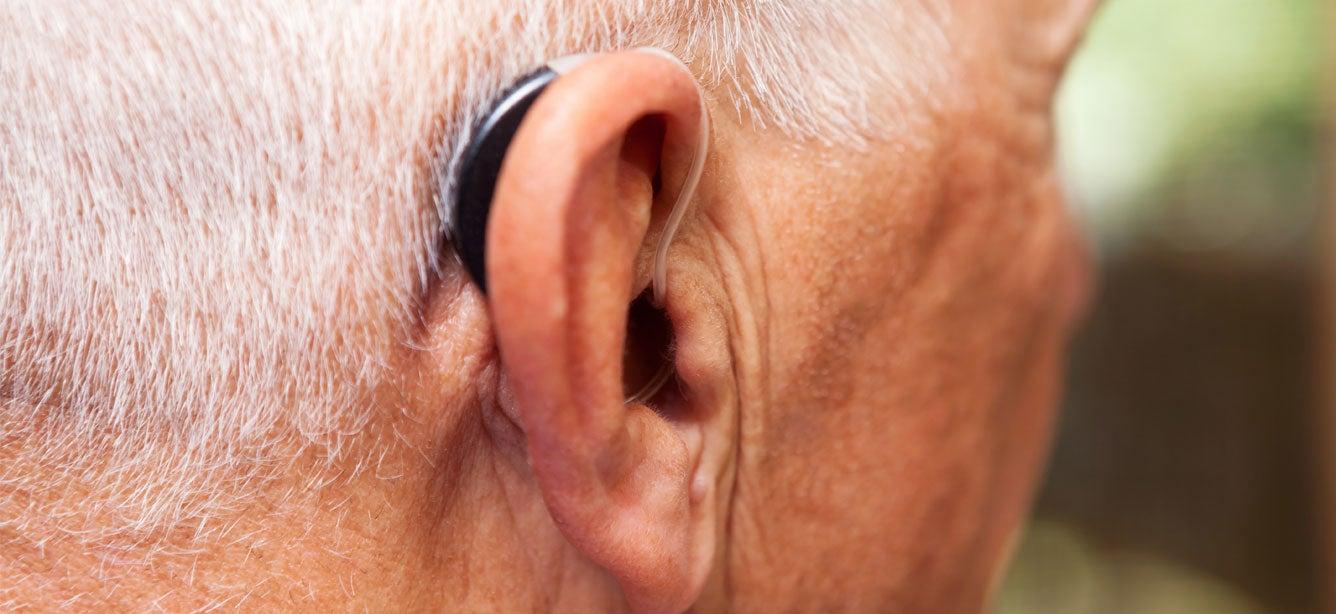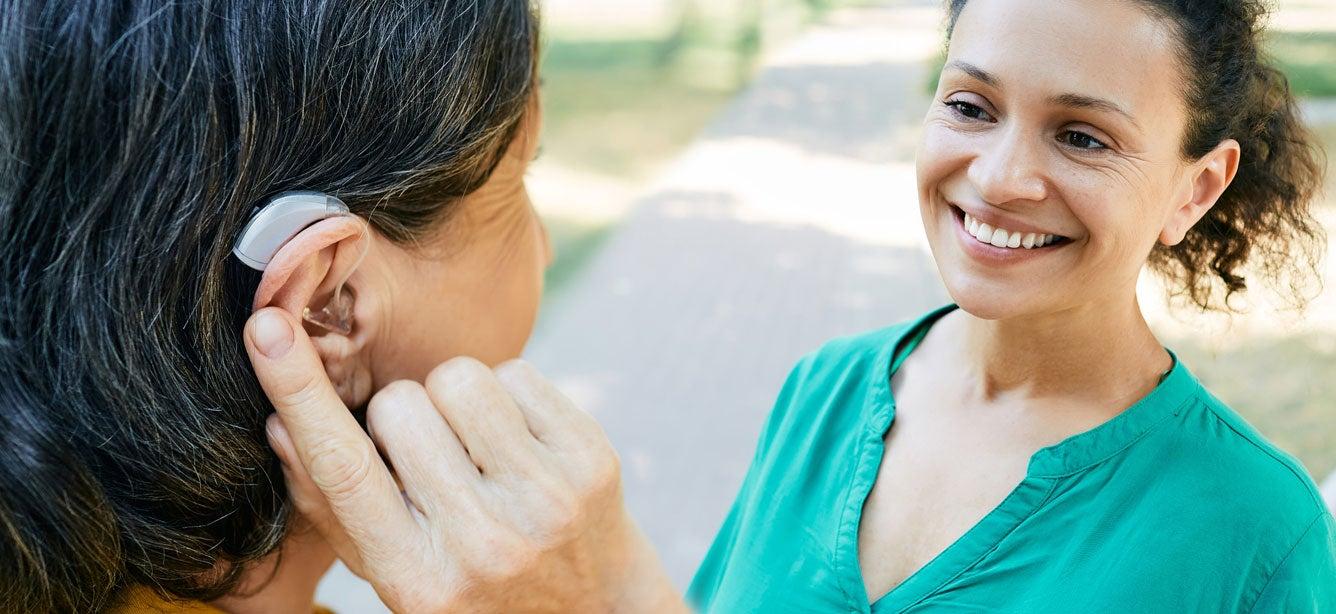
Related Topics
Choosing a hearing aid can sometimes feel overwhelming because there are so many options available. But untreated hearing loss can affect our mental health, social life, and brain function, so it’s best to start hearing again as soon as possible.
Our hearing aid buyers guide can help you make a confident decision.
How to buy hearing aids
The hearing aid buying process looks a little different depending on the type you need. You can buy over-the-counter (OTC) hearing aids online, but prescription devices require a series of in-person appointments. There are pros and cons to each.
How to purchase prescription hearing aids
An ear, nose, and throat doctor, audiologist (hearing specialist), or hearing aid dispenser must examine your ears and administer a hearing test before you can purchase a prescription hearing aid. These professionals diagnose the cause of your hearing loss and determine whether hearing aids are the most appropriate treatment.
After the exam, your health care provider will discuss different types of hearing aids and let you try on a few models. You don’t have to make an immediate decision. Ask for brochures and other take-home materials that can help you weigh your options. You’re also not locked in to purchasing a hearing aid from the doctor who diagnosed your hearing loss. Each hearing care provider sets their own prices, so it’s OK to shop around and find the best prescription hearing aid that works for you and your budget.
Once you make a decision, the hearing care professional will order the device for you and schedule a fitting appointment. At this appointment, they’ll program the hearing aid according to the results of your audiogram—a graph that visually represents the results of your hearing test, showing the softest sounds a person can hear—and demonstrate how to use it. You may be asked to schedule one or more follow-up visits to make sure the hearing aid works for you and fits properly.
How to purchase OTC hearing aids
Anyone can buy OTC hearing aids—you don’t need to see a professional at any point in the buying process. But experts recommend you get an in-person hearing exam first to rule out any causes of your hearing loss that can’t be treated with hearing aids. For example, your hearing loss could be caused by impacted ear wax, which can be treated without hearing aids by a professional in their office.
OTC hearing aids are available to adults at least 18 years old with mild to moderate hearing loss. You can buy them online directly from the brand or from popular retailers like Amazon and Walmart. Some models can also be purchased in brick-and-mortar stores like Best Buy. Pay close attention to the return policy so you can get a refund if the hearing aids don’t meet your needs.
Based on our research, look for OTC hearing aids with at least a 45-day trial period (we’ve seen OTC hearing aid companies offer up to 100-day trial periods) so you have enough time to test the hearing aids yourself.
What to consider when selecting hearing aids
You’ll want to think about many factors when choosing the best one for you. Your degree of hearing loss, style preferences, and budget help to narrow your choices. Extra features like battery life, Bluetooth compatibility, and custom settings help you compare differences between models as you make a final decision.
Degree of hearing loss
Hearing aids can address different degrees of hearing loss. Take a hearing test to determine the degree of hearing loss in each ear before selecting a hearing aid.
A degree of hearing loss is defined by the amount of amplification required for the person to hear:
- Mild hearing loss: 26–40 decibels (dB)
- Moderate hearing loss: 41–55 dB
- Moderately severe hearing loss: 56–70 dB
- Severe hearing loss: 71–90 dB
- Profound hearing loss: 90 dB or higher
OTC hearing aids are approved for mild to moderate hearing loss only. Prescription hearing aids can treat any degree of hearing loss, depending on the style and model.
Hearing aid style
Hearing aids come in several different styles. Their names refer to the location of the receiver (the speaker):
- Behind-the-ear (BTE)
- Receiver-in-canal (RIC)
- In-the-ear (ITE)
- In-the-canal (ITC)
- Completely-in-canal (CIC)
- Invisible-in-canal (IIC)
Bigger hearing aids can fit more technology and larger, more powerful receivers, making them more appropriate for treating severe and profound hearing loss.
Behind-the-ear hearing aids
As their name implies, behind-the-ear (BTE) hearing aids include a housing unit that sits behind the ear. The housing unit is like the brains of the hearing aid. Sound travels from the receiver to the ear canal via a thin plastic tube. People with profound hearing loss are often limited to this style of hearing aid because it supports the largest receivers.
Receiver-in-canal hearing aids
At first glance, receiver-in-canal (RIC) hearing aids look like BTE hearing aids, but there’s a key difference: The receiver is nestled in the ear canal instead of in the housing unit behind the ear. This improves sound quality and allows for a smaller, more discreet housing unit.
In-the-ear hearing aids
An in-the-ear (ITE) hearing aid tucks the receiver into the ear canal while a housing unit rests in the bowl of the ear. This style easily fits custom ear molds.
In-the-canal hearing aids
In-the-canal (ITC) hearing aids are smaller than in-the-ear devices but visibly stick out of the ear canal. They can look similar to a pair of wireless earbuds.
Completely-in-canal hearing aids
Completely-in-canal (CIC) hearing aids fit snugly inside the ear canal but may be visible from certain angles. The hearing aid is removed by tugging on a small, clear wire that sticks out of the ear canal.
Invisible-in-canal hearing aids
Invisible-in-canal (IIC) hearing aids sit even deeper inside the ear than CIC devices. When properly inserted, the housing unit can’t be seen from any angle. Only the removal wire sticks out from the ear canal. These types of hearing aids must be administered by a hearing professional. Because IIC hearing aids can only fit the smallest receivers, they’re best-suited for people with mild to moderate hearing loss.
Hearing aid features
Hearing aids can have many different features to suit your needs and budget. At minimum, a good hearing aid should clarify speech in noisy environments while maintaining a battery life of at least 18 hours. Rechargeable batteries are increasingly common in hearing aids, but you can still purchase a model that uses disposable batteries if you’re concerned about downtime. It’s worth noting if you have dexterity issues, rechargeable batteries may be easier since they don’t require you to swap out small batteries regularly.
Of all the features available in hearing aids today, customizable frequency bands are perhaps the most important because they let you choose the exact level of amplification for each sound frequency. For example, you might need 4,000 Hz amplified by 20 decibels, but no amplification at 8,000 Hz. Without customizable frequency bands, there’s no guarantee the hearing aid will support your unique pattern of hearing loss.
Bluetooth is another popular feature that allows users to stream audio from phones, TVs, and other devices for better sound clarity, listen to sound generators that mask tinnitus symptoms, and control their hearing aids through an app.
How much do hearing aids cost?
Hearing aid costs vary considerably, from about $100 to more than $7,000. We analyzed the prices of more than 100 hearing aids and found the average pair of hearing aids costs about $2,100.
OTC hearing aids tend to be less expensive than prescription hearing aids, averaging around $930 per pair compared to an average cost of $3,300 for prescription devices.
Hearing care providers set their own prices for prescription devices and often bundle fitting services and follow-up care into the total price. Ask what’s included in the cost of the hearing aid to avoid surprise service bills. For people new to hearing aids or with higher degrees of hearing loss, fitting services and follow-up care may be helpful to ensuring you’re happy with your hearing aids. Many OTC hearing aids offer remote fittings and adjustments, which may be enough support for experienced hearing aid users.
Prescription hearing aids also come in different performance levels, which affects the final price. It’s like buying a car—if you want all the bells and whistles, expect to pay top dollar. If you can live without cutting-edge technology, consider a lower performance level to save money.
How to find affordable hearing aids
Affordable hearing aids are more likely to be OTC models. To get a free or low-cost prescription hearing aid, start by asking your hearing care provider about financial assistance or free demo models. Demo models are typically older, discontinued hearing aids that still work but are no longer needed for in-office demonstrations.
For a list of organizations offering hearing aid assistance, view our guide to Medicare and hearing health.
And to find hearing benefits in your area, check out BenefitsCheckUp®.
Medicare and insurance coverage
Original Medicare (Part A and Part B) typically doesn’t cover hearing care, but there are exceptions. With a referral from your doctor, Medicare Part B covers a diagnostic hearing and balance exam once every 12 months.
Medicare Part B beneficiaries may also visit an audiologist once every 12 months without a referral when seeking treatment for a chronic hearing condition or a condition related to a surgically implanted hearing device like a cochlear implant or bone-anchored hearing aid.
Many Medicare Advantage (Part C) plans offer benefits for hearing exams and hearing aids. Consult your explanation of benefits document or contact your insurance company for details.
What to expect when you first get new hearing aids
When you first get new hearing aids, expect a bit of discomfort. It can take several weeks or months to adjust to a louder world. “When starting hearing aids, you have to be prepared to deal with some minor inconveniences. Loud sounds like a blender running or an ambulance passing by might be more forceful than you've remembered,” said Anish V. Thakkar, AuD, a doctor of audiology and founder of Los Angeles Center for Hearing and Balance.
Properly fitted hearing aids should never cause pain, but your ear canal may itch a little and you may feel sensitive to some sounds as you get used to the devices.
People with hearing loss often say their own voice sounds odd once they start wearing hearing aids. Some also report tinnitus after wearing hearing aids for the first time, but it’s usually temporary. Sounds may tinny or robot-like, and it may be difficult to understand some words or accents at first. “These issues tend to naturally resolve as the brain gets accustomed to the hearing aids,” said Thakkar. “Daily usage—preferably 10 hours or more—helps your brain get used to your hearing aids faster.”
For extra guidance during the transition from hearing loss to hearing aids, ask your hearing care provider about rehabilitation services.
How to care for your hearing aids
Hearing aids may not perform well if they’re clogged with wax or exposed to excess sweat and moisture.
To care for your hearing aids, wipe them down with a soft cloth every day. Once per week, gently remove the ear dome and use a soft bristle brush to wipe wax off the filter that covers the receiver. The filter should be replaced every one to three months, or whenever it’s full of wax.
Most hearing aids come with a care kit, but you may need to purchase extra components like wax filters. If your hearing aids often get wet, consider a dehumidifier to thoroughly dry them out. Some hearing clinics offer hearing aid drying services that take about 15 minutes to suck moisture out of your devices.
For people with low vision, the small size of hearing aid parts can make caring for hearing aids more difficult. A hearing clinic can help you understand how to clean your hearing aids and align the batteries correctly. Also, many hearing clinics offer free or low-cost cleaning services.
Frequently asked questions
How do I choose a hearing aid?
To choose the right hearing aid for you, be sure to consider three main things: your degree of hearing loss, the style of hearing aid that can address your level of hearing loss, and your budget. You can learn your level of hearing loss by taking a hearing test. But not all hearing aids can address all levels of hearing loss. Be sure to choose a hearing aid that’s powerful enough for you.
Is it better to get a hearing aid from an audiologist?
In general, it’s better to get a hearing aid from an audiologist or hearing clinic since you’ll get more in-person support and post-purchase care. But bying hearing aids from a hearing clinic is also more expensive than OTC hearing aids. For those who cannot afford a prescription hearing aid from a hearing clinic, OTC hearing aids can still help address hearing loss.
Should you have a hearing test before buying a hearing aid?
You should always have a hearing test before buying a hearing aid. You can take hearing tests online or in person. If you’ve never used a hearing aid before, experts recommend you get an in-person hearing test done by a hearing professional (like an audiologist or hearing instrument specialist) to rule out any causes of your hearing loss that can't be addressed with hearing aids.




